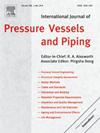Charpy V-notch energy prediction for irradiated reactor pressure vessel steel using the extreme gradient boost method
IF 3
2区 工程技术
Q2 ENGINEERING, MECHANICAL
International Journal of Pressure Vessels and Piping
Pub Date : 2025-05-19
DOI:10.1016/j.ijpvp.2025.105559
引用次数: 0
Abstract
We have developed a Charpy V-notch energy (CVE) prediction model using the extreme gradient boost (XGBoost) method for irradiated pressure vessel steels as recorded in the Reactor Embrittlement Archive Project database. The model demonstrated reasonable prediction accuracy with a root mean square error (RMSE) of 21.0 ± 1.7 J, a mean absolute percentage error (MAPE) of 32.4 ± 3.5 %, and a coefficient of determination (R2) of 0.87 ± 0.02 for the test dataset. The prediction performance of the newly developed model showed improvement over that of the model for non-irradiated material. The parameters that most significantly influence the prediction model have been identified. By using the newly developed model, it became possible to reproduce the average behavior, i.e., the Charpy curve, for CVE data on each plant and material. In other words, by using the XGBoost model, we have made it possible to predict the indexes used in the current surveillance test framework, such as the Ductile to Brittle transition temperature shift (ΔT41J). The value of ΔT41J predicted using our model is compatible to that by the current embrittlement trend curve model.
用极端梯度升压法预测辐照反应堆压力容器钢的Charpy v缺口能量
我们开发了一个Charpy v型缺口能量(CVE)预测模型,使用极端梯度boost (XGBoost)方法,用于记录在反应堆脆化档案项目数据库中的辐照压力容器钢。该模型具有较好的预测精度,均方根误差(RMSE)为21.0±1.7 J,平均绝对百分比误差(MAPE)为32.4±3.5%,决定系数(R2)为0.87±0.02。新建立的模型的预测性能比未辐照物质的模型有所提高。确定了对预测模型影响最大的参数。通过使用新开发的模型,可以重现每种植物和材料的CVE数据的平均行为,即Charpy曲线。换句话说,通过使用XGBoost模型,我们可以预测当前监测测试框架中使用的指标,例如韧脆性转变温度变化(ΔT41J)。该模型预测的ΔT41J值与现有脆化趋势曲线模型的预测值基本一致。
本文章由计算机程序翻译,如有差异,请以英文原文为准。
求助全文
约1分钟内获得全文
求助全文
来源期刊
CiteScore
5.30
自引率
13.30%
发文量
208
审稿时长
17 months
期刊介绍:
Pressure vessel engineering technology is of importance in many branches of industry. This journal publishes the latest research results and related information on all its associated aspects, with particular emphasis on the structural integrity assessment, maintenance and life extension of pressurised process engineering plants.
The anticipated coverage of the International Journal of Pressure Vessels and Piping ranges from simple mass-produced pressure vessels to large custom-built vessels and tanks. Pressure vessels technology is a developing field, and contributions on the following topics will therefore be welcome:
• Pressure vessel engineering
• Structural integrity assessment
• Design methods
• Codes and standards
• Fabrication and welding
• Materials properties requirements
• Inspection and quality management
• Maintenance and life extension
• Ageing and environmental effects
• Life management
Of particular importance are papers covering aspects of significant practical application which could lead to major improvements in economy, reliability and useful life. While most accepted papers represent the results of original applied research, critical reviews of topical interest by world-leading experts will also appear from time to time.
International Journal of Pressure Vessels and Piping is indispensable reading for engineering professionals involved in the energy, petrochemicals, process plant, transport, aerospace and related industries; for manufacturers of pressure vessels and ancillary equipment; and for academics pursuing research in these areas.

 求助内容:
求助内容: 应助结果提醒方式:
应助结果提醒方式:


